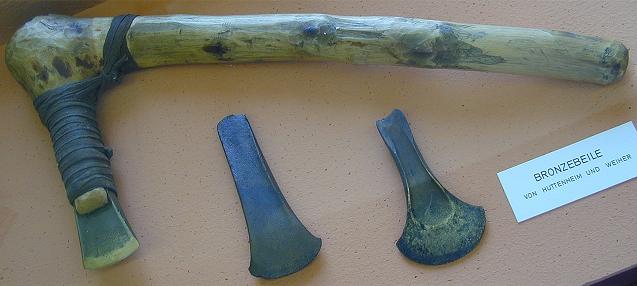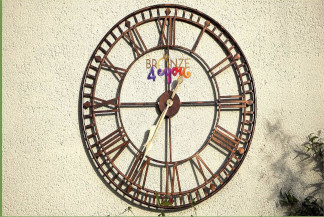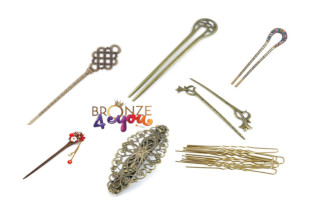
This is the second period of the Metal Age that began in the year 3000 B.C. and finished about 1200 B. C.
Let us first make a summary of the Metal Age to better understand and then we focus on the Bronze Age.
Age of Metals
According to historians, Prehistory is divided into two periods. The first period is the Stone Age and the second period is the Metal Age. As its name refers to the main feature of the Metal Age, it is the use of metals by human beings.
This era of humanity is marked by the birth of metallurgy and the manufacture of metal tools for agriculture and livestock and the construction of combat weapons. Said metallurgy development begins on different continents such as Europe, Africa, and Asia.
It is said that metallurgy developed because they not only began to replace the stone with metals but also began to work them, make alloys. These new tools caused a breakthrough in agriculture. As a result of the use of more efficient tools, they had better and greater productions, which generated the appearance of trade.
Other developments related to the use of metals were the improvement of food and the creation of more complex social structures and larger cities.
This period covers 3 millennia BC and is divided into three stages:
- Copper or Chalcolithic Age
- Bronze Age
- Iron Age
Go to concentrate on the second stage that is the Bronze Age.
Bronze Age Definition
Is the second period of the Age of Metals which began in 2500. C. This Period beginning based on the metallurgical knowledge that different civilizations had on copper, both in its extraction and in the techniques of smelting and forging of said metal.
While copper and gold appeared in nature and only had to be treated, bronze required prior metallurgical work.
Metallurgical artisans observed that although copper and tin were metals of soft consistency, their combination allowed a stronger metal to be obtained. This feature allowed the bronze to be positioned as a more useful metal because of its hardness and strength compared to copper. Both copper and tin are metals that melt at relatively low temperatures compared to other metals. They could be melted with a wood fire and easily melted and spilled the alloy into molds to create things like ax heads, swords, daggers, arrows, etc.
Bronze Age Stages
We must consider that the world of that era was not globalized or communicated as we know it today. That makes the discoveries or the arrival of metallurgy, in that case, it was at different times. The Bronze Age in Mesopotamia did not begin at the same time as in Africa, Greece or the East.
The typical divisions of the Near Eastern Bronze Age have a well-established triadic expression clarity. The dates and phases of the period below apply only to the Near East and, therefore, do not apply universally.
Divisions of the Near Eastern Bronze Age
Early Bronze Age (3300–2100 BC). It was characterized by the collective burial of corpses. It is a society primitive dedicated to hunting and fishing. The first activities arise the commercialization of metals. As for the armament the first flat axes similar to those of stone appear.
Middle Bronze Age (2100–1550 BC). Human beings of this age begin to travel for business purposes. The first buildings arise. Here there is a leap in terms of the evolution in the weapons of war and its military/military organization because their weapons are already more individual. Thus swords and rapier are forged.
Late Bronze Age (1550–1200 BC). It is the period of transition towards the iron age. There is a great cultural transformation. Tombs emerge as a symbol of power and social status. Settlements also appear in high places with walls and large forts. From the war point of view, a greater variety of swords and spearheads arises. War clothing is also manufactured (hearts, shields, helmets, etc.).
You may also like…
Bronze Age Tools
The tools that were invented with the activities that were developed are closely related.
During this stage of human history, the development and quality of life of civilizations became more remarkable. In many settlements or cities, it was increasingly common to manufacture tools and weapons more effectively than those made with stone or copper. The growth of ingenuity in the manufacture of metal utensils allowed simplifying daily activities in each society.
Moreover, the settlementsthey were more organized and dedicated to activities such as hunting, fishing, agriculture and livestock raising, which was developed more efficiently thanks to the integration of metal instruments to these activities. Even so, the use of bronze in the different civilizations of the era did not become popular in the same period.
In Metallurgy
When melting copper with tin and forming bronze, they used stone and clay molds in the early Bronze Age to shape objects such as spears and axes. They even did it in series.
Bronze Age Domestic Products
The arrival of bronze helped improve the manufacture of domestic products, which facilitated everyday life at home, among them we can cite the different vessels, vases, and other decorative products. Also razors, buckets. The large handicrafts made increased the number of trade agreements between different people. Also in their cultures and funeral rituals where they replaced the collective burials by the individual inboxes called cistas.
Bronze Age Agriculture Tools
The arrival of bronze caused a series of great tools to be created for agricultural production, serving to greatly improve productivity and thereby creating the first cases of a product capable of making a population live no need to move its location, and even there are cases in which they were able to get enough surplus to trade.
Previously the raw material had been carved stone, with much less chance than any metal.
Among the most popular utensils made with these metals were knives (which could be sharpened easily), containers, axes and plows more efficient or implements that multiplied the possibilities of harvest.
Means of transport
The creation of the different cities made it necessary to manufacture new means of transport, thanks to which it became easier to trade and move from one point to another. Being able to move more easily to more distant places was key to the discovery of new metal mines. The greater use of horses with carriages and the improvement in navigation with sails on ships.
War Armament
Bronze was a much more useful material for creating weapons than the materials that had been used so far. Bronze turned out to be harder and easier to mold metal. The appearance of weapons such as bronze swords caused great changes in the society of the time, making the great cultures that had evolved the manufacture of weapons with bronze easily conquered other people.
The metal did not splinter, nor did it break and could bend, strike and mold in more efficient ways. Bronze weapons, often interchangeable, including axes, swords, knives, daggers, spearheads, helmets, cauldrons, horns, shields and many other objects useful for war.
Bronze Age Technology
The civilization in this period have played a very important role in human development and technological innovations. During this time, the human brain produced many wonderful tools and inventions that not only helped in the advancement of everyday life but also formed the basis for future nations and civilizations to excel.
Bronce Age Inventions
Another important feature of the Metal Age is the emergence of new inventions in various fields. One of them was the transport, necessary to move the metals or products with which it was wanted to trade.
Two examples of these innovations are the wheel, for land transport; and the sail, for the sea or river. On the other hand, it began to use the plow thrown by animals and the mill to crush the wheat thus expanding the capacity of agriculture.
Another point of differentiation was the nascent investigation to prolong the useful life of what was eaten. Among the most used methods was salting.
Finally, the improvement of hunting weapons allowed the meat to be easier to obtain, as happened with fishing. According to experts, this ease in access to the meat together with the domestication of animals, typical of previous stages, produced a great improvement over time past.
Others Inventions
The rope is another important invention that was made in the Bronze Age. The credit for this invention goes to the ancient Egyptians.
The umbrella was also invented during the Bronze Age and the exact time was 2400 a. C. Although different civilizations developed different instruments to protect themselves from rain, however, the first appropriate umbrella was invented by the Egyptians.
Kites also developed during the Bronze Civilization. Yes, of course, as today, these kites were developed to meet the recreational needs of the general population. cteThe Chinese bronze civilization is the first that created the comets. That is because they had the materials such as high strength silk that are required for the construction of comets.
Another important military innovation of the Bronze Age was Crimped Ax. The ax was predominantly used by the Middle Eastern Mesopotamian armies. The ax was a serious weapon and gave a good competitive age to the army that was equipped with it. Once it was invented, later generations also used this ax for almost 2000 years.
Bronze axes were mainly used for agriculture and it was much more difficult compared to a normal stone ax. The ax’s head contained a ring that helped the ax get damaged. The Bronze Ax is also considered one of the most shocking innovations of the Bronze Age.
The plows that were manufactured in the previous era were made of wood or stone. The bronze plow could receive strong impacts without being damaged.
New trades of the Bronze Age
One of the causes of these social differences and the hierarchy that entails was the emergence of new trades. The first important ones were those related to metals, such as blacksmiths or goldsmiths.
The trade also resulted in the appearance of its professionals. These merchants were essential for the city to increase its wealth and recognition.During the bronze age, the first civilizations and the social division arise. The elite of high social status was that of the warriors.
Bronze Age Collapse
The Bronze Age ends with the dominance of iron, which gives rise to the third and final stage of metals: The Iron Age. When the use of bronze began to decrease and iron became the new technology.
The Bronze Age ended abruptly around the year 1200B.C. in the Middle East, North Africa, and Mediterranean Europe. Historians do not know for sure what caused the collapse of the Bronze Age, but many believe that the transition was sudden, violent and culturally disruptive.
The main civilizations of the Bronze Age, including Mycenaean Greece, the Hittite Empire in Turkey and ancient Egypt fell in a short period. Ancient cities were abandoned, trade routes were lost and literacy declined throughout the region.
Scholars believe that a combination of natural disasters may have brought down several empires of the Bronze Age. Archaeological evidence suggests a succession of severe droughts in the eastern Mediterranean region for 150 years from 1250 to 1100 BC. C. probably featured prominently in the collapse. Earthquakes, hunger, socio-political unrest, and invasion of nomadic tribes may also have played an important role.



